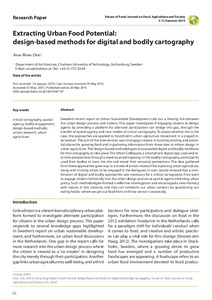| dc.date.accessioned | 2015-05-27T07:58:00Z | |
| dc.date.available | 2015-05-27T07:58:00Z | |
| dc.date.issued | 2015-05-20 | |
| dc.identifier.issn | 2197-411X | |
| dc.identifier.uri | urn:nbn:de:hebis:34-2015031947797 | |
| dc.identifier.uri | http://hdl.handle.net/123456789/2015031947797 | |
| dc.language.iso | eng | |
| dc.publisher | Department of Organic Food Quality and Food Culture at the University of Kassel, Germany and Federation of German Scientists (VDW) | eng |
| dc.rights | Urheberrechtlich geschützt | |
| dc.rights.uri | https://rightsstatements.org/page/InC/1.0/ | |
| dc.subject | critical cartography | eng |
| dc.subject | spatial agency | eng |
| dc.subject | bodily engagement | eng |
| dc.subject | design-based methods | eng |
| dc.subject | artistic research | eng |
| dc.subject | urban agriculture | eng |
| dc.subject.ddc | 630 | |
| dc.title | Extracting Urban Food Potential: design-based methods for digital and bodily cartography | eng |
| dc.type | Aufsatz | |
| dcterms.abstract | Sweden’s recent report on Urban Sustainable Development calls out a missing link between
the urban design process and citizens. This paper investigates if engaging citizens as design
agents by providing a platform for alternate participation can bridge this gap, through the
transfer of spatial agency and new modes of critical cartography. To assess whether this is the
case, the approaches are applied to Stockholm’s urban agriculture movement in a staged intervention.
The aim of the intervention was to engage citizens in locating existing and potential
places for growing food and in gathering information from these sites to inform design in
urban agriculture. The design-based methodologies incorporated digital and bodily interfaces
for this cartography to take place. The Urban CoMapper, a smartphone digital app, captured real-time perspectives through crowd-sourced mapping. In the bodily cartography, participant’s
used their bodies to trace the site and reveal their sensorial perceptions. The data gathered
from these approaches gave way to a mode of artistic research for exploring urban agriculture,
along with inviting artists to be engaged in the dialogues. In sum, results showed that a combination
of digital and bodily approaches was necessary for a critical cartography if we want
to engage citizens holistically into the urban design process as spatial agents informing urban
policy. Such methodologies formed a reflective interrogation and encouraged a new intimacy
with nature, in this instance, one that can transform our urban conduct by questioning our
eating habits: where we get our food from and how we eat it seasonally. | eng |
| dcterms.accessRights | open access | |
| dcterms.bibliographicCitation | In: Future of Food: Journal on Food, Agriculture and Society. Witzenhausen : University of Kassel, Department of Organic Food Quality and Food Culture. - Vol. 3, No. 1 (2015), S. 48-62 | |
| dcterms.creator | Orrù, Anna Maria | |

